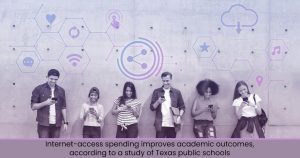Increased internet-access spending by Texas public schools improved academic performance and led to more disciplinary problems among students, a study of 9,000 schools conducted by a research team from Rice University, Texas A&M University and the University of Notre Dame shows.
According to the researchers, whether students benefit from increased internet access in public schools has been an open question. For example, some parents and policy advocates contend it increases children’s access to obscene or harmful content and disciplinary problems. Others believe it promotes personalized learning and higher student engagement.
The research team created a multi-year dataset (2000-14) of 1,243 school districts representing more than 9,000 Texas public schools to address these policy questions. The team measured internet-access spending, 11 academic performance indicators and 47 types of school disciplinary problems. It used econometric techniques to develop causal estimates linking internet-access spending to academic performance and disciplinary problems. Using student earning, the researchers calculated the economic impact of increased annual internet spending.
To date, this is the largest and most comprehensive study linking school internet-access spending to academic and disciplinary outcomes, the researchers said.
The team found that increased school district internet spending is associated with improved graduation rates and higher numbers of students meeting SAT/ACT criterion and completing advanced courses. It also led to an improvement in commended performance in math, reading, writing and social studies. Interestingly, the researchers noted that these improvements were stronger for students in countries with greater internet access (as measured by the number of broadband providers).
On the flip side, increased school district internet spending also led to more serious disciplinary problems at schools, they said.
The team also calculated how much economic benefit a school district’s internet access would bring students during their lifetimes. It found that a $600,000 increase in annual internet-access spending produces a financial gain of approximately $820,000 to $1.8 million per school district, together with losses from disciplinary problems totalling $25,800 to $53,440.
In other words, investments in internet access are well worth the costs.
“We are proud that Texas public schools can serve as a live learning case for understanding education policy,” said study co-author Vikas Mittal, a professor of marketing at Rice’s Jones Graduate School of Business. “Investments in internet access provide clear and meaningful academic benefits. Yet, schools need to implement policies to address increased disciplinary issues such as cyberbullying.
“K-12 education has transformed into virtual learning due to COVID-19,” he continued. “Our research conclusions apply to a setting where physical learning is supplemented by internet access.”
However, Mittal cautioned that these benefits could not be expected to hold if physical learning is wholly supplanted by internet-based learning.
Source: Science Daily
Blending Online Learning with Textbooks can help prepare students for their courses in the discipline and employment in the field. To contribute to virtual classroom discussions, select a textbook that supports course topics from a wide range of textbooks published by PHI Learning.
For more information, visit us at www.phindia.com
